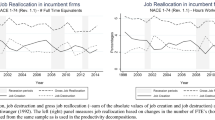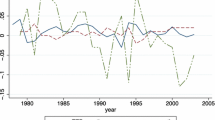Abstract
Capital stock data for the U.S. economy are used to develop a measure of sectoral shifts in productive resources. Within the context of the creative destruction process, this measure provides a direct indicator of sectoral shifts in resource demands independent of aggregate fluctuations. Years with greater reallocations of capital have higher unemployment, a result consistent with the traditional sectoral shifts hypothesis. However, fluctuations in unemployment appear to be more strongly influenced by aggregate rather than sectoral shocks. Significant variation exists across demographic groups in the responsiveness of unemployment to aggregate fluctuations and sectoral shifts. The adverse impact of sectoral shifts is greater for males and members of the nonwhite labor force.
Similar content being viewed by others
References
Abraham, Katharine; Katz, Lawrence. “Cyclical Unemployment: Sectoral Shifts or Aggregate Disturbances,”Journal of Political Economy, 94, 3, June 1986, pp. 507–22.
Black, Fischer.Business Cycles and Equilibrium, New York, NY: Basil Blackwell, 1987.
Brainard, Lael; Cutler, David. “Sectoral Shifts and Cyclical Unemployment Reconsidered,”Quarterly Journal of Economics, 108, 1, February 1993, pp. 219–43.
Bureau of Economic Analysis:Estimates of Fixed Reproducible Tangible Wealth: 1929–95, data diskette, Washington, DC: U.S. Dept. of Commerce, 1997.
__.Fixed Reproducible Tangible Wealth in the United States: 1925–94, Washington, DC: U.S. Dept. of Commerce, 1999.
Caballero, Ricardo; Hammour, Mohamad. “On the Timing and Efficiency of Creative Destruction,”Quarterly Journal of Economics, 111, 3, August 1996, pp. 805–52.
Chirinko, Robert. “Business Fixed Investment Spending: A Critical Survey of Modeling Strategies, Empirical Results, and Policy Implications,”Journal of Economic Literature, 31, 4, December 1993, pp. 1875–911.
Davis, Steven. “Allocative Disturbances and Specific Capital in Real Business Cycle Theories,”American Economic Review, 77, 2, May 1987a, pp. 326–32.
__. “Fluctuations in the Pace of Labor Reallocation,”Carnegie-Rochester Conference Series on Public Policy, 27, 1987b, pp. 335–402.
Gordon, Robert J. “The Time-Varying NAIRU and its Implications for Economic Policy,”Journal of Economic Perspectives, 11, 1, Winter 1997, pp. 11–32.
Hall, Thomas.Business Cycles: The Nature and Causes of Economic Fluctuations, New York, NY: Praeger Publishers, 1990.
Katz, Arnold; Herman, Shelby. “Improved Estimates of Fixed Reproducible Tangible Wealth: 1929–95,”Survey of Current Business, 77, 5, May 1997, pp. 69–76.
Katz, Lawrence. “Some Recent Developments in Labor Economics and Their Implications for Macroeconomics,”Journal of Money, Credit, and Banking, 20, 3, August 1988, pp. 507–22.
Lilien, David. “Sectoral Shifts and Cyclical Unemployment,”Journal of Political Economy, 90, 4, August 1982, pp. 777–93.
Loungani, Prakash. “Oil Price Shocks and the Dispersion Hypothesis,”Review of Economics and Statistics, 68, 3, August 1986, pp. 536–9.
Loungani, Prakash; Rush, Mark; Tave, William. “Stock Market Dispersion and Unemployment,”Journal of Monetary Economics, 25, 3, June 1990, pp. 367–88.
Neal, Derek. “Industry-Specific Human Capital: Evidence from Displaced Workers,”Journal of Labor Economics, 13, 4, October 1995, pp. 653–77.
Parker, Jeffrey. “Structural Unemployment in the United States: The Effects of Interindustry and Interregional Dispersions,”Economic Inquiry, 30, 1, January 1992, pp. 101–16.
Phelps, Edmund.Inflation Policy and Unemployment Theory, New York, NY: W. W. Norton, 1972.
__.Structural Slumps, Cambridge, MA: Harvard University Press, 1994.
Roberts, John. “New Keynesian Economics and the Phillips Curve,”Journal of Money, Credit, and Banking, 27, 4, November 1995, pp. 975–84.
Shin, Kwanho. “Inter- and Intrasectoral Shocks: Effects on the Unemployment Rate,”Journal of Labor Economics, 15, 2, April 1997, pp. 376–401.
Stadler, George. “Real Business Cycles,”Journal of Economic Literature, 32, 4, December 1994, pp. 1750–83.
Toledo, Wilfredo; Marquis, Milton. “Capital Allocative Disturbances and Economic Fluctuations,”Review of Economics and Statistics, 75, 2, May 1993, pp. 233–40.
Author information
Authors and Affiliations
Rights and permissions
About this article
Cite this article
Blackley, P.R. The impact of sectoral shifts in investment on unemployment in U.S. labor markets. Atlantic Economic Journal 28, 435–449 (2000). https://doi.org/10.1007/BF02298396
Issue Date:
DOI: https://doi.org/10.1007/BF02298396




